Date : October 10, 2019
Notice: Toshima City (Tokyo) Press Tour
post date : 2019.09.20
Theme: Moving beyond being “a city at risk of vanishing”—Toshima’s challenge
Population decline and an aging population is progressing throughout Japan, and is becoming a pressing problem in Tokyo as well, which until now has driven Japan’s economic growth by youth from around the country gathering there. The Tokyo Metropolitan Government has estimated that Tokyo’s population will begin declining after reaching its peak in 2025.
Toshima Ward, one of Tokyo’s 23 wards, is located to the northwest among the wards. Along with Shinjuku and Shibuya, its central area Ikebukuro is one of Tokyo’s main entertainment districts. The ward’s population has been gradually increasing, and grew to more than 290,000 in 2018 for the first time in 40 years. It has the highest population density in the country.
However, in a report released by the Japan Policy Council, a private think tank, in 2014, Toshima was the only one of Tokyo’s 23 wards to be singled out as a “city at risk of disappearing.” The report listed 896 municipalities throughout Japan where the population of women aged 20 to 39 was expected to halve from 2010 to 2040, leading to an unavoidable and rapid population decline, and so the report suggested these local governments were at risk of disappearing in the future. The news that Toshima Ward, home to the popular youth area of Ikebukuro, was included in this list of regional governments struggling with depopulation, was a major shock to people throughout Japan.
Since then, Toshima Ward has made a clear plan for its future, “creating a city easy for women to live in,” and has been carrying out initiatives to ensure it is a town young women and families will want to move to and continue living in, with ample support for raising children and efforts to keep the town safe. In order to renew its image and become a place people choose to live in, Toshima has also developed a vision for the future as a “City of International Art and Culture,” and leading up to 2020 the area around Ikebukuro Station has undergone significant redevelopment as it is reborn as a new center for art and culture. In 2017, Toshima was ranked No. 1 overall in Japan in a survey of “cities where it is easy to raise children while both partners work,” and has been gaining attention as a model for measures to deal with population decline in urban areas.
Five years have passed since the shocking declaration of being a city at risk of disappearing. This press tour will cover the initiatives implemented by Toshima Ward, one of the first places in Tokyo to respond to the approaching crisis of population decline.
[Tour Details]
1. Interview with Toshima Mayor Yukio Takano
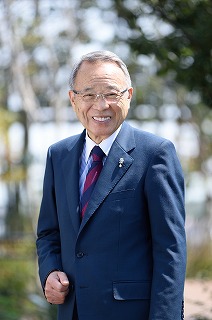
After being listed as a city at risk of disappearing, Toshima Ward immediately established an emergency task force and began looking into possible countermeasures. In order to hear from the people directly involved, the ward established the Toshima F1 Conference consisting mainly of women in their 20s and 30s, and incorporated ideas from there into its policies. To ensure these policies were strongly promoted, the ward also established a “Female-friendly urban development section.” The head of this section was hired from the private sector through open recruitment.
Mayor Yukio Takano says that “It was a shock” to be listed as a city at risk of disappearing, but by working together with the public, who were concerned about the risk, various measures were quickly implemented and Toshima noticeably changed. The “City of International Art and Culture” concept is one of those measures, and art is also being used to create a city easy for women to live in.
The orientation will explain population trends in Toshima Ward, which was listed as a city at risk of disappearing, along with an explanation of the measures the ward has implemented and their results. In the interview with the mayor, he will discuss how he took a leading role in making a city easy for women to live in, and community development through culture.
Photo provided by Toshima Ward Office
2. Global Kids Higashi-Ikebukuro Daycare
-Building a new daycare in a high-rise ward office building and everywhere else to eliminate the waiting list for daycares
One initiative Toshima Ward worked especially hard on was eliminating the daycare waiting list, in order to make Toshima more convenient for families with children and encourage them to live there over the long term. The number of daycares was increased as much as possible, using whatever space was available, including inside a grocery store and an apartment building. As a result, the number of children on the daycare waiting list steadily fell from the 240 it was when Toshima was designated as a city at risk of disappearing in fiscal 2014, and was zero for two years running in fiscal 2017 and 2018.
Global Kids Higashi-Ikebukuro Daycare opened in April 2017 in the 49-story Toshima Ward Office building, one of the new daycares built to eliminate the waiting list. The daycare has capacity for up to 60 children, from 0 to 5 years old. This is the first case in Japan of a licensed daycare being opened in a government building. Although it does not have its own yard, the children take walks in nearby Minami-Ikebukuro Park or in the rooftop garden on the 10th floor of the building.
After hearing about Toshima’s initiatives to eliminate the daycare waiting list, the tour will see what daycares are like now at Global Kids Higashi-Ikebukuro Daycare. The tour will join the daycare children on their walk to Minami-Ikebukuro Park, and see the children playing in the park as if it was their own yard.

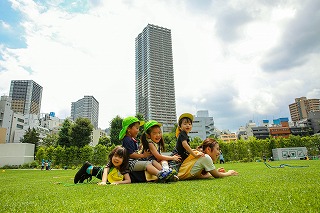
Photos provided by Global Kids Higashi-Ikebukuro Daycare
3. Minami-Ikebukuro Park
-Changed parks lead to a changed town
With the concept that “parks can change towns,” Toshima Ward has been working on improving its parks. In preparation for 2020, four parks in the area around Ikebukuro Station, totaling 30,000 square meters, are being redeveloped, and one of them is Minami-Ikebukuro Park, a five-minute walk from Ikebukuro Station. This park, located in a corner of the entertainment district and surrounded by buildings, used to be covered in trees and was known as a place where homeless people gathered, so most residents avoided it. In April 2016, it was reopened as it is now, with beautiful green grass. A fashionable cafe and restaurant also opened in the park, eliminating its previous image of being dark and unfriendly, and now people of all ages visit it from all over, including young women and families. The area around the park has also become more vibrant, and the town as a whole is changing noticeably.
With many of the new daycares not having their own yards, Minami-Ikebukuro Park is one of the approximately 160 parks in Toshima that daycares can use instead, and daycares visit them frequently.
The tour will visit Minami-Ikebukuro Park, which has been compared to Central Park in New York City, and hear about Toshima Ward’s efforts to change the town starting by changing the parks.

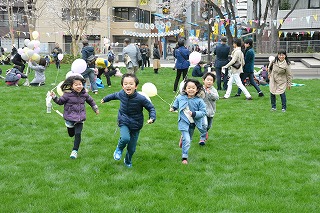
Photos: provided by Toshima Ward Office
4. Minami-Nagasaki Park: Art Toilets
-Renovating public restrooms into bright, clean spaces from the perspectives of women and children
From the Toshima F1 Conference and other places, Toshima Ward heard from women that the public restrooms in parks were old, dirty, and scary, and people with children wanted restrooms that they could use without worrying. In response, Toshima has been putting efforts into improving their public restrooms. Believing that if the restrooms were improved, women and children would go to the parks and the value of the town would increase, the Toshima Public Toilet Project was started in fiscal 2017, a three-year project to fully renovate 85 of the 133 public washrooms in Toshima Ward.
To make bright, appealing restrooms, some were made into “Art Toilets” with murals on their exterior and interior, in collaborations with young artists and local children. The Art Toilet in Minami-Nagasaki Park, located in a residential area, has bright mural displaying daily life in the town covering its exterior, made by local illustrator Mr. Yasumichi Inoue.
The tour will visit the Minami-Nagasaki Park Art Toilet, and hear from Toshima Ward about efforts to make a city easy for women to live in by improving the public restrooms. Mr. Inoue will also speak about his thoughts behind creating the mural.

5. Renovation of We Road, an Underground Walkway
-The rebirth of a “dark, dirty, and dangerous” underground walkway as an art space that anyone can walk along comfortably
We Road is a public underground passage along the north of Ikebukuro Station connecting the west side and east side. This 77-meter passage, built in 1925, is used by over 30,000 people per day, but as it grew older it acquired a negative perception of being “dark, dirty, and scary,” and women avoided using it.
Currently, We Road is undergoing renovations to make it into a space that women and everyone else will feel comfortable using, once again through the use of art. Artist Ms. Shiho Ueda is in charge of its interior design. Ms. Ueda asked residents what their feelings were on We Road, and over the course of approximately a year has been using colors to represent those feelings in murals on the walls and ceiling. The project is planned to be completed in November 2019.
The tour will see the wall mural being made, now in its final stages, and speak with Ms. Ueda.
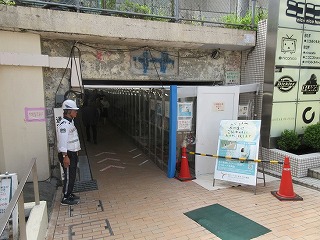

Photos: provided by Toshima Ward Office
6. Sheena & Ippei
-A café and guesthouse made using a vacant building built 45 years ago, becoming a center for a sustainable town
With 15.8% of buildings being vacant, Toshima Ward has the highest vacancy rate of Tokyo’s 23 wards. The ward has been carrying out “renovation community building” with the goal of using vacant buildings and vacant lots to create a town full of children where it is fun to raise children. Part of these efforts was a renovation school. Participants from various walks of life including architects, designers, company employees, and housewives worked together as teams to develop concrete renovation business plans for vacant properties in Toshima. (The Renovation Community Building Project was carried out from fiscal 2014 to 2016.)
The first business from this project, Sheena & Ippei, opened in Shiinamachi in March 2016. A former tonkatsu restaurant, built 45 years ago and vacant for years, located in a traditional shopping arcade, was reborn through renovation as a fashionable community café and guesthouse. The first floor is a community café with sewing machines available for use and a communal kitchen for locals. In addition to being a place where young parents and veteran parents can interact through handicrafts, by making people raising children visible in a café along the shopping arcade the goal is to promote the fact that you can raise families here to younger generations, and prevent them moving to other areas. The second floor of the building is a guesthouse with five rooms. With the concept of Shiinamachi as a whole being the guesthouse, guests are expected to bath at the local public bath, and eat at restaurants around town. The area is popular with foreign tourists as a place where you can “experience daily life in Tokyo,” in a town that still has a traditional atmosphere. This renovated vacant building has become a center for exchange between different generations and between locals and visitors, bringing energy to the community.
The tour will hear from Mr. Koichi Hikamiyama, president of Sheena Town Co., Ltd., which operates Sheena & Ippei, about the project to create a sustainable town with Sheena & Ippei.


7. Shiinamachi Children’s Cafeteria
-Watching over and raising the local children as a community
With child poverty and eating alone becoming social issues, children’s cafeterias where children can go even if they are alone and eat for little or no cost are growing in popularity throughout Japan.
Currently, there are 13 children’s cafeterias throughout Toshima. One of these is the Shiinamachi Children’s Cafeteria, operated by the NPO Toshima Children Wakuwaku Network (Director: Chieko Kuribayashi). Twice per month, local volunteers provide healthy, warm meals. Children up to high school age eat for free, and the price for adults is 300 yen. It is open to all the children in the area and their parents, not only to struggling households, and each time 80 to 100 people eat there. The 40 seats available fill up as soon as it opens at 18:00. In addition to being a place where children can happily eat together, it also provides busy parents the opportunity to relax for at least one meal instead of making it themselves, and so is supporting numerous local families.
Toshima Children Wakuwaku Network was a pioneer in operating children’s cafeterias in Japan. The NPO runs four children’s cafeterias in Toshima, including the Shiinamachi Children’s Cafeteria. Its director, Ms. Kuribayashi, was inspired to do so when she was involved in running a play park for children, where she encountered children who were not eating every meal or were sleeping in cars.
The tour will visit the Shiinamachi Children’s Cafeteria, and hear from the NPO Toshima Children Wakuwaku Network’s secretary general, Ms. Keiko Amano, about the children’s cafeteria initiative to watch over and raise children as a community, as well as seeing the cafeteria itself.
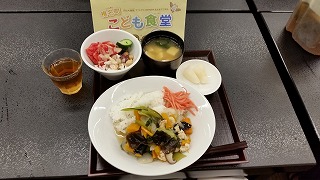


Photos provided by NPO Toshima Children Wakuwaku Network
8. Hareza Ikebukuro
-Ikebukuro changing into a center for cultural promotion ahead of 2020
Ikebukuro, the center of Toshima, is undergoing a change moving towards 2020. In July 2020, Hareza Ikebukuro will have its grand opening, becoming a symbol of Toshima as a City of International Art and Culture, located in the former Ward Office Building. This entertainment complex will have a total of eight venues, including a movie theater, a large performance hall, and smaller live music venues. The Tokyo Tatemono Brillia Hall, with seating for 1300 and will host performances such as kabuki and musicals, and the Toshima Resident Center will open first in November 2019. Additionally, four parks will open in the Ikebukuro Tozai area by spring 2020, including Minami-Ikebukuro Park, and a bright red electric bus, the Ikebus, will travel between them.
The tour will see Hareza Ikebukuro, and hear an explanation of the dynamic redevelopment Ikebukuro is undergoing. The tour will also have the opportunity to ride on the Ikebus, which is planned to begin operation in November.



Photos provided by Toshima Ward Office
[Tour Itinerary]
1. Schedule
*The schedule is not yet finalized, and may change without notice.
<Thursday, October 10>
8:30 Meet at Toshima City Hall/Toshima Ward Office Building
8:45-9:30 Orientation
9:30-10:45 Global Kids Higashi-Ikebukuro Daycare
10:45-11:15 Minami-Ikebukuro park
11:30-12:00 We Road
12:25-12:55 Art Toilets (Minami-Nagasaki Park)
13:10-13:50 Lunch
13:50-14:50 Sheena & Ippei
15:15-16:00 Hareza Ikebukuro
16:30-17:20 Interview with Toshima Mayor
17:40-19:00 Shiinamachi Children’s Cafeteria
19:00 Tour ends at Shiinamachi Station
2. Qualification: Bearer of Gaimusho Press Registration Card
3. Cost: 2,000 Yen per person including transportation in Toshima and lunch.
*Information on payment and cancellation fee will be provided to participants.
*You are responsible for the round transportation fee to and from Toshima by yourself.
4. Participants: Limited to 10 applicants.
(Only one reporter or one photographer from each company, but two participants from each TV team will be acceptable.)
*If the number of applicants exceeds 10, an upper limit may be set on the number of participants from each country/region.
5. FPCJ Contact: Junya Sugawara and Mayuko Onishi (Tel: 03-3501-3405、E-mail: ma@fpcjpn.or.jp)
6. Remarks:
(1) This tour is organized by the Toshima Ward Office and operated by the FPCJ.
(2) The schedule is subject to change without notice.
(3) This tour will require participants to bear part of the cost, but is not a profit-making venture.
(4) Neither the organizer nor FPCJ will be liable for any inconvenience, trouble or accidents that might occur during the tour.
(5) There may be some restrictions on photographing and filming at the tour sites. Please follow the instructions of the staff in charge.



